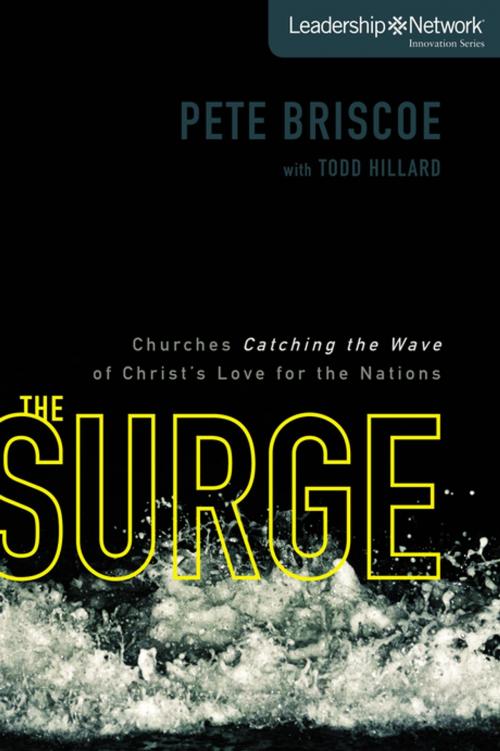The Surge
Churches Catching the Wave of Christ's Love for the Nations
Nonfiction, Religion & Spirituality, Christianity, Evangelism, Church| Author: | Pete Briscoe | ISBN: | 9780310323167 |
| Publisher: | Zondervan | Publication: | November 23, 2010 |
| Imprint: | Zondervan | Language: | English |
| Author: | Pete Briscoe |
| ISBN: | 9780310323167 |
| Publisher: | Zondervan |
| Publication: | November 23, 2010 |
| Imprint: | Zondervan |
| Language: | English |
When Jesus left the planet, he left a simple directive in his apprentice’s ears: take me to the world, bring them into the family, and teach them to obey me… and don’t worry I’ll be with you every step of the way. So the system was turned on its ear. Instead of “Bring the people to me” Jesus said, “Take me to the people”. This book highlights the imperative need for the Church of Jesus Christ to be a sending culture, taking Jesus to the people who desperately need him. It focuses specifically on the awesome responsibility the blessed church of the West has in this regard to reach out globally. When Pete Briscoe arrived at Bent Tree they had “prophecy conferences.” Desiring to focus on the part of the puzzle that we can actually do something about (the great commission) they immediately shifted the emphasis to a Mission Festival. At that time they were investing just $36,000 per year in world missions, and all but one of their missionaries was on American soil. They implemented Faith Promise giving, gave opportunities for mission partners to make compelling presentations, included mission moments in their worship services, brought in mission experts to speak at a mission festival, increased giving to over $1 million annually, gave 10% of expansion giving ($2.6 million) to the world church, adopted the world’s largest unreached people group and have a desire to see a church planted in every one of the 200,000 villages in the region, and much more…This book is necessary because the American church has forgotten this simple truth: “the church of Jesus Christ exists primarily for the benefit of its non-members.” The Seeker Movement helped to remind Evangelicals of the need to reach out to Seekers, but the model was a replica of the “Bring to” Model of the Old Testament. Pete Briscoe realized early in his pastorate that people in his church viewed evangelism as, “bring them to church to hear Pete.” While obviously there are times when this is a healthy strategy to reach the lost, we are missing the mark if it becomes the dominant method. Add to this, the minimal concern for the vast regions of the world that still have yet to hear of the gospel, and the burgeoning numbers of church leaders around the planet that have little or no theological training, and you start to get a feel for the angst and concern that drives this project. There is an imperative need for an awakening in the Western church to see beyond the boundaries not only of our Church Building, but of our Community as well. We have turned a “blind eye” in attempting to reach our communities. The author would like to encourage us to turn a “kind eye” to those outside our sphere of influence who are inside our ability to touch. This is a call from a Pastor to the Church to “Lift up their eyes (again) to see the harvest.” Here’s what readers can receive from the book:* Examples of a church that has kept mission at the front and seen God do amazing things as a result. * Detailed and simple processes to help church leaders implement some simple strategies to change the culture in their church.* Help to create a paradigm shift in fund raising for missions.* Opened eyes to the enormous need and incredible potential impact the American church has.* Demonstration of how to grow children and youth with a heart for the world.* A workable model from Acts 1:8. Acts 1:8 providing a good framework for strategic expansion. Many churches today are focusing on the Jerusalem piece and the Judea part is covered with the new multi-site phenomenon. But what does a Samaria strategy look like and how do we impact the ends of the earth? Acts 1:8 keeps all four spheres before us.* Sharing of the personal journey of a pastor who leads a mission minded church.* Practical and usable tools such as a grid for evaluation potential missionaries, an evaluation process for current mission partners, mobilization techniques for keeping a church connected to her m
When Jesus left the planet, he left a simple directive in his apprentice’s ears: take me to the world, bring them into the family, and teach them to obey me… and don’t worry I’ll be with you every step of the way. So the system was turned on its ear. Instead of “Bring the people to me” Jesus said, “Take me to the people”. This book highlights the imperative need for the Church of Jesus Christ to be a sending culture, taking Jesus to the people who desperately need him. It focuses specifically on the awesome responsibility the blessed church of the West has in this regard to reach out globally. When Pete Briscoe arrived at Bent Tree they had “prophecy conferences.” Desiring to focus on the part of the puzzle that we can actually do something about (the great commission) they immediately shifted the emphasis to a Mission Festival. At that time they were investing just $36,000 per year in world missions, and all but one of their missionaries was on American soil. They implemented Faith Promise giving, gave opportunities for mission partners to make compelling presentations, included mission moments in their worship services, brought in mission experts to speak at a mission festival, increased giving to over $1 million annually, gave 10% of expansion giving ($2.6 million) to the world church, adopted the world’s largest unreached people group and have a desire to see a church planted in every one of the 200,000 villages in the region, and much more…This book is necessary because the American church has forgotten this simple truth: “the church of Jesus Christ exists primarily for the benefit of its non-members.” The Seeker Movement helped to remind Evangelicals of the need to reach out to Seekers, but the model was a replica of the “Bring to” Model of the Old Testament. Pete Briscoe realized early in his pastorate that people in his church viewed evangelism as, “bring them to church to hear Pete.” While obviously there are times when this is a healthy strategy to reach the lost, we are missing the mark if it becomes the dominant method. Add to this, the minimal concern for the vast regions of the world that still have yet to hear of the gospel, and the burgeoning numbers of church leaders around the planet that have little or no theological training, and you start to get a feel for the angst and concern that drives this project. There is an imperative need for an awakening in the Western church to see beyond the boundaries not only of our Church Building, but of our Community as well. We have turned a “blind eye” in attempting to reach our communities. The author would like to encourage us to turn a “kind eye” to those outside our sphere of influence who are inside our ability to touch. This is a call from a Pastor to the Church to “Lift up their eyes (again) to see the harvest.” Here’s what readers can receive from the book:* Examples of a church that has kept mission at the front and seen God do amazing things as a result. * Detailed and simple processes to help church leaders implement some simple strategies to change the culture in their church.* Help to create a paradigm shift in fund raising for missions.* Opened eyes to the enormous need and incredible potential impact the American church has.* Demonstration of how to grow children and youth with a heart for the world.* A workable model from Acts 1:8. Acts 1:8 providing a good framework for strategic expansion. Many churches today are focusing on the Jerusalem piece and the Judea part is covered with the new multi-site phenomenon. But what does a Samaria strategy look like and how do we impact the ends of the earth? Acts 1:8 keeps all four spheres before us.* Sharing of the personal journey of a pastor who leads a mission minded church.* Practical and usable tools such as a grid for evaluation potential missionaries, an evaluation process for current mission partners, mobilization techniques for keeping a church connected to her m















